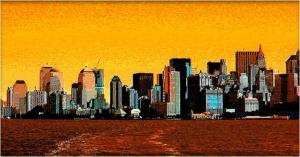- 1 read

Cities may seem in a constant state of war with garbage - just look at what happened in Naples two years ago when disposal ground to a halt and trash piled up on street corners. Ideally, people would limit the amount of easily disposable goods they consume, but so long as trash is produced at the levels it is now, cities might as well do something with it. If used creatively, trash can combat environmental degradation and even liven up neighborhoods. Here are three ways waste has been incorporated into urban planning.
Artificial Land
Pick a large city, and it’s bound to have a neighborhood built on trash. Some examples: Manhattan’s Battery Park City, on the southernmost tip of the island, was built in the 1980s on construction waste from the World Trade Center, and San Francisco’s classy Marina District sits on a landfill. If cities are to expand, they might as well do so on landfills rather than natural habitats (wetlands, which provide a natural drainage system for rainwater, are particularly at risk from new development.) Some cities do the opposite, and convert garbage dumps into public parks where plants and animals can flourish. In Westchester County, just north of New York City, families picnic along the Hudson River at Croton Point Park, formerly the Croton Landfill. One of the most innovate examples is Pulau Semakau, an island about five miles off the coast of Singapore. It’s made of construction waste and dust from Singapore’s four garbage incinerators, and was designed to support a diverse ecosystem. Mangroves and rare species of bird thrive there. And as a bonus, eco-tourists come to the island to take guided walking tours, providing a boost to Singapore’s economy.
Fuel
Landfills release tons of methane – a greenhouse gas 20 times more powerful than carbon – contributing to the warming of the planet. What if that substance were captured and used to fuel nearby cities? According to the Boston Globe, 425 landfills across the country convert methane into fuel, and “780,000 homes nationwide receive their power and nearly 1.2 million residences their heat from dumps.” At landfill about an hour outside San Francisco, California’s Waste Management Company shelled out over $15 million to build the country’s largest methane processing plant. For now, the 13,000 gallons of fuel it churns out each day will be used to power garbage collection trucks. But down the road, it has potential to provide electricity to countless San Francisco homes.
Public Art
In one of Philadelphia’s bohemian enclaves, there's a sculpture garden assembled entirely out of found objects. What I didn’t notice at first was that the exhibit extended to the historic row house next door. Everything from the boiler room to the chimney had been plastered with mirrors, bottles, broken tiles and other landfill-bound trinkets (including wooden statues of Buddha and Hindu gods). After a fight to keep it open in 2002, the garden and house became a permanent outdoor gallery of sorts, managed by a non-profit. Whimsical and eye-catching, it helped revitalize the neighborhood (artist Isaiah Zagar and his wife bought and renovated several properties in the area), and kept tons of trash, much of it non-biodegradable, out of the earth.

